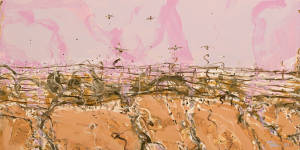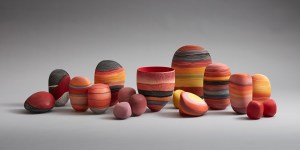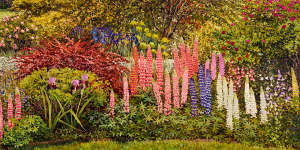The only areas in which Australia may be said to have made an original contribution to world art are Aboriginal art and landscape,certainly not portraiture. We may have been present at the birth of Conceptual Art as well,but that’s nothing to boast about.
For most of the 120 years of the Wynne,Aboriginal art was not included or considered to be “art” at all. Within the past decade,that pattern of shameful neglect has been turned around so successfully that Indigenous artists now dominate.,Nicholas Harding,has been the only non-Indigenous painter to take out the prize within the past seven years.

Winner of the 2023 Wynne Prize Zaachariaha Fielding with his work,Inma.Steven Siewert
For a while,there was even a special Aboriginal Wynne-within-the-Wynne,sponsored by Andrew Roberts and family,but that seems to have lapsed. Nobody could argue any longer that First Nations artists need special encouragement. Four of the five winners of the Roberts prize have been APY artists.
The same is true for. Zaachariaha Fielding is better known as a pop star – one half of the duo,Electric Fields. Born in Mimili in the APY lands,he says he took up painting during the COVID-19 lockdowns of 2020. Fielding’s progress has been so spectacular that his entry was judged superior to works by artists with decades of experience,including.

The late John Olsen’s The Lake Recedes.Supplied
Is this credible? Of course. Art history is packed with prodigies who displayed exceptional natural talent,and Fielding is obviously talented. It’s another question whether it was a good idea to give the prize to a member of the APY collective when that operation – and this very artist - that white assistants are responsible for painting part of the work.
This is not the place to take up that thorny issue which still has a long way to run,but Fielding’s victory,and the presence of another five APY artists in the exhibition,suggests a lack of caution on behalf of the AGNSW,if not a disregard for a set of serious charges.
It’s important to recognise that many of the most vehement critics of APY are Indigenous,including some with first-hand experience of the art centres.
This issue was the elephant in the room on the day the winners were announced. Nobody wanted to mention it at the time,but it is casting a pall over much subsequent discussion of the Wynne.
If I try and ignore the elephant and simply attend to the work,there’s no denying that Fielding’sInma is a large,spectacular picture – an explosive collection of drips and swirls surrounding four amoebic shapes,in shades of black,white and cream. Yet,it’s that very spectacle,echoed in more colourful paintings by Yaritji Heffernan and Sally Scales,that I find discouraging. There’s a mechanical feeling about much of the APY work that I don’t get from the paintings of other Indigenous finalists,such as Mantua Nangala and Dhambit Mununggurr,even though there is a good deal of repetition in their work.

Pippin Drysdale’s Wolfe Creek Crater Installation.Supplied
Repetition is one of the most curious phenomena in art. With some artists,it acts as a cumulative force that builds from one piece to the next. In others,the reverse applies,as the life is systematically drained from canvases that initially seemed exciting. This is not something that can be proven objectively,but every dedicated viewer of art will know what I’m talking about.
Had the AGNSW trustees sought a little controversy they might have considered Pippin Drysdale’sWolfe Creek Crater Installation - a group of largely non-functional ceramics displaying bands of colour that suggest the distinctive colours of the outback. The work is a landscape rather than a sculpture,but it captures a spirit of place with greater success than most of the Wynne paintings.
If there was a prize for opportunism it would go to Michael Snape’sThe Voice,a wooden sculpture that spells out the letters V-O-I-C-E in the vague shape of a standing figure. James Powditch has also taken an oblique route,adapting an honour board from an old sporting club so that it features the names of all previous winners of the Wynne. The trustees couldn’t resist the gag,even if it requires imagination to classify the piece as either a landscape or a figurative sculpture. It reminds me of a student essay that’s gone off-topic but deserves a good mark because of the effort involved.

Lucy Culliton’s Bibbenluke,Spring.Supplied
It would have been fascinating to eavesdrop on the trustees’ deliberations when they stood in front of John Olsen’sThe Lake Recedes. When a giant of Australian art has died only weeks before,and one of his last paintings is submitted for judgement,there would have been considerable pressure to award this work the prize. What’s more,it’s good enough to win even if Olsen had been an unknown.
The judges may have reacted against oppressive expectations,or they may have felt it would be merely a sentimental choice. suggests youth was one of their big priorities this year.
Among other artists who might have been considered,John R. Walker and Lucy Culliton contributed two of their best-ever Wynne entries – Culliton’s densely paintedBibbenluke,Spring and Walker’s loose,nervyVinbana-Yura-Mulka (Breakneck Gorge)testify to many years of experience.
The Wynne is not awarded for long service,but experience is a quality that leaves its imprint on a painting or a sculpture. Artists learn their trade over time,recognising their limitations and figuring out how to overcome them. It’s a long,gradual process of self-discovery that doesn’t happen overnight or arrive in a spontaneous splash of paint. Had Culliton or Walker taken out the Prize,let alone Olsen,we could honestly say they had earned it. For Fielding,it’s like winning the lottery.
The Wynne Prize is at theArt Gallery of NSW (along with the Archibald and Sulman prizes) until September 3.